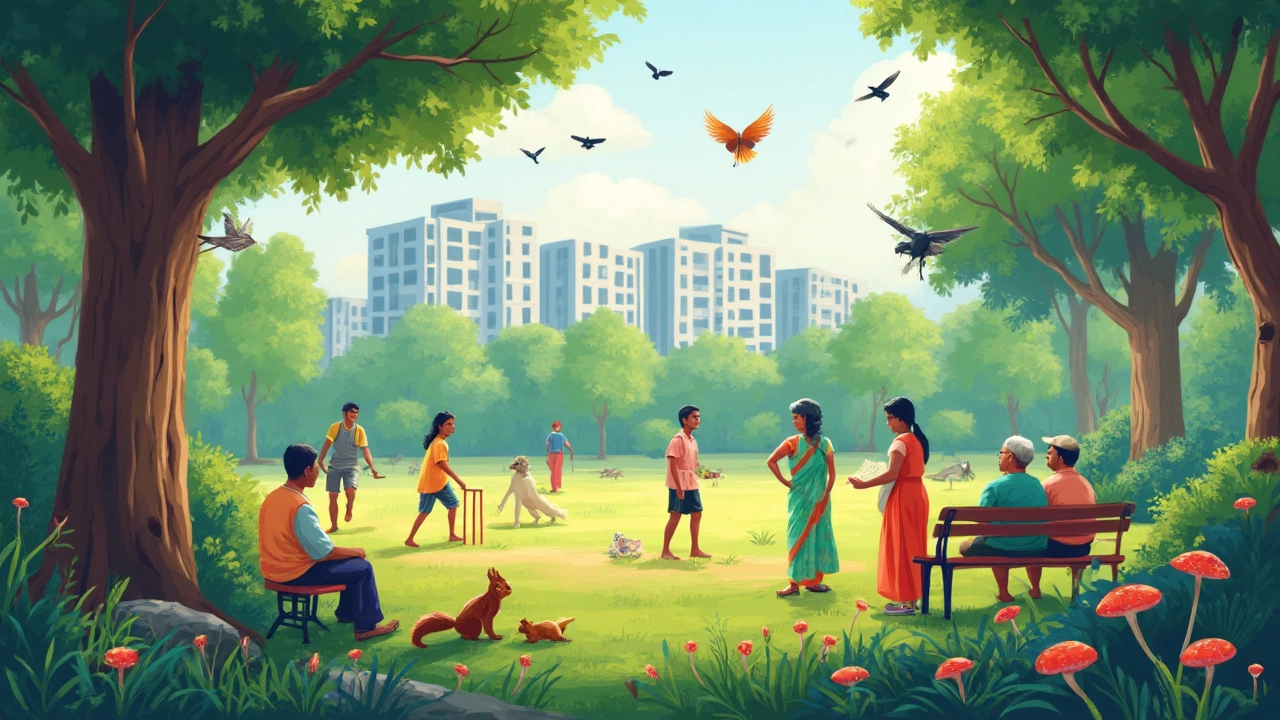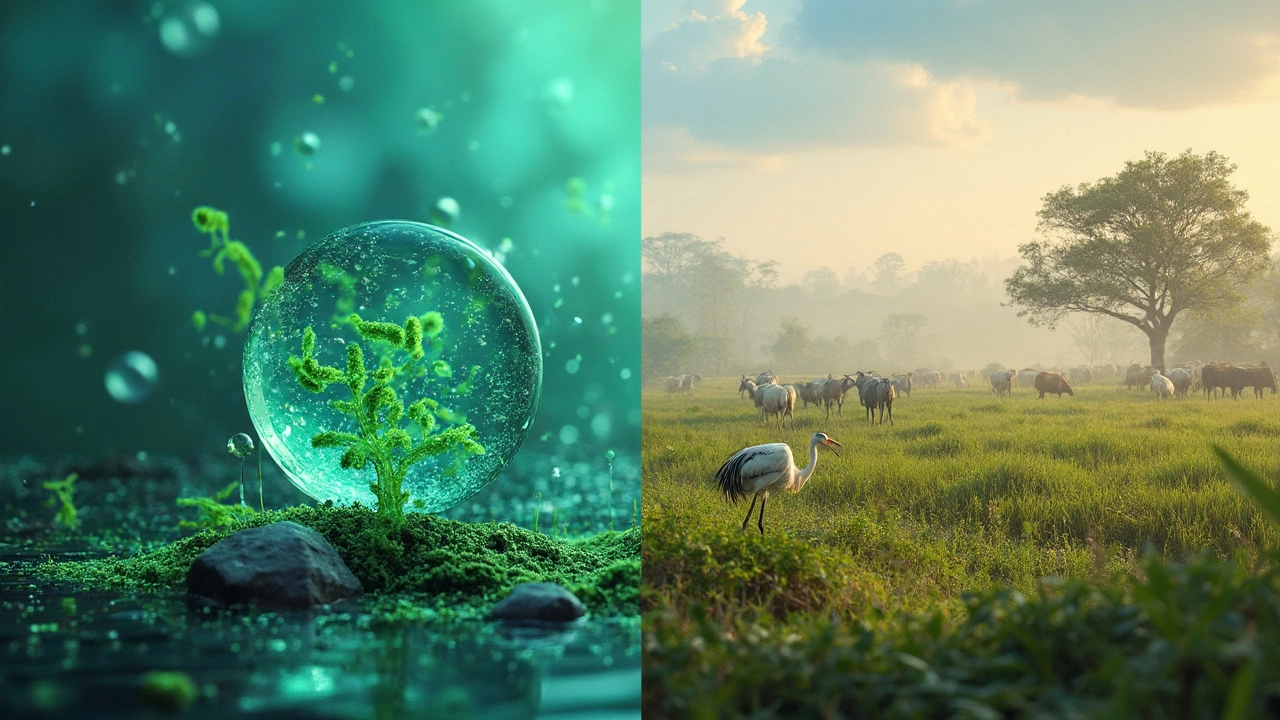Ever look at a patch of grass and wonder who’s actually living there? It’s more than just what you see—ecosystems are a wild mix of different communities, all tangled up and making things work. Figuring out which communities do what is key if you love nature or want to help protect it. Every group, from tiny pond critters to big forests, plays its own part.
Ecosystem communities aren’t just a science class thing. They actually shape the air we breathe, keep soil healthy, and even feed us. Once you see how these groups work, you’ll start noticing them everywhere—your backyard, a city park, even that stubborn moss on a sidewalk. If you want to get involved with environmental groups or support local habitats, knowing these community types sets you up to make real impact, not just guesses. Let’s break down what makes each one unique and why they matter more than you might think.
- What Makes a Community in an Ecosystem?
- Major Types of Ecological Communities
- Examples: From Microbes to Mammals
- Why These Communities Matter
- Spotting and Supporting Local Ecosystem Communities
What Makes a Community in an Ecosystem?
So, what actually counts as a community in an ecosystem? Think of it like a neighborhood, but instead of houses and people, it’s patches of plants, groups of bugs, flocks of birds, and pretty much any collection of living things all hanging out in the same area. A community isn’t just a random pile-up. It’s all the different species living together in a certain spot—and it matters because they interact, depend on each other, and get shaped by their surroundings.
One quick fact: a single teaspoon of soil can have more than 1 billion bacteria, all from thousands of different species. That’s a microscopic community hard at work under your feet. These communities include things you see, like squirrels and oaks, but also things you’d never notice unless you looked under a microscope or watched over time.
Communities in ecosystems are built around a few key ingredients:
- Species diversity: The total number of different plants, animals, fungi, and microbes living together.
- Habitat: The place where the community lives—could be a pond, a patch of forest, or even the underside of a fallen log.
- Interactions: Who eats whom? Who competes? Who helps who grow? These links create a real network that keeps everything moving.
Here’s a quick visual on how community size and diversity can change based on the environment:
| Type of Habitat | Average # of Species (per 100 sq. meters) | Examples |
|---|---|---|
| Old-Growth Forest | 50-100 | Oaks, ferns, frogs, beetles |
| Urban Park | 15-30 | Grasses, pigeons, ants |
| Wetland Pool | 25-60 | Reeds, water bugs, fish |
| Desert Patch | 5-15 | Cacti, lizards, beetles |
Every community, no matter how big or small, ends up playing a part in healthy ecosystem communities. The mix of who’s living together, how many there are, and how connected they are shapes everything that happens in that space—like how fast plants grow, which birds visit, or even how much carbon gets pulled from the air.
Next time you’re out for a walk, stop and take a look. Try to spot a few different living things in the same area, and imagine all the invisible connections between them. That’s the core of a community in action.
Major Types of Ecological Communities
Ecological communities are really just groups of different species living together in certain spots, all connected by what they eat, where they hang out, and how they help (or compete with) each other. Scientists put these communities into clear types based on size, location, and who’s in them. It's more organized than you might think.
Here are the main types you’ll come across:
- Ecosystem communities in forests: These cover big areas with tons of different species—trees, birds, fungi, insects, and mammals. The Amazon Rainforest, for example, is home to over 390 billion trees. Forests break down into smaller spots like canopy (tree tops), understory (small trees and shrubs), and forest floor, each with their own crews of plants and animals.
- Grassland communities: Wide open fields where grasses dominate but you’ll also spot grazing animals, insects, birds, and even digging mammals. The African savanna has zebras, lions, and acacia trees all tangled in a food web.
- Freshwater communities: Found in ponds, lakes, rivers, and wetlands. You get fish, frogs, algae, water birds, and insects living together. Wetlands clean water by filtering out toxins and support nearly 40% of all species worldwide at some life stage.
- Marine communities: These are ocean-based. Think coral reefs with thousands of fish and tough little polyps building the reef structure. Mangroves, kelp forests, and open ocean zones each form specific communities with unique combinations of life.
- Urban communities: Even cities have their own mix—pigeons, squirrels, rats, street trees, pollinators, and the occasional fox. These wildlife groups adapt to traffic, pollution, and constant noise.
To keep it visual, here’s a quick breakdown of the most common types, with what makes each unique and a real-world example:
| Community Type | Main Features | Example |
|---|---|---|
| Forest | Diverse plants, layers (canopy, understory), lots of animal species | Amazon Rainforest (South America) |
| Grassland | Mostly grasses, grazing animals, periodic fires | Serengeti Plains (Africa) |
| Freshwater | Standing or flowing water, aquatic plants, fish, amphibians | Florida Everglades (USA) |
| Marine | Saltwater, coral reefs or kelp forests, high animal diversity | Great Barrier Reef (Australia) |
| Urban | Human-built, adapted wildlife, street trees, fragmented habitats | Central Park (New York City, USA) |
Each community type is shaped by the climate, available water, and who moves in or out. When any of these pieces change—like a forest being cleared for farms or a wetland filled in for buildings—the whole community shifts or sometimes disappears. That’s why protecting even the "boring" looking grassland or wetland can be just as important as saving rainforests. Pay attention to who shares your local area; the mix is more unique than most people expect.

Examples: From Microbes to Mammals
You might be surprised how wild the variety is when it comes to ecosystem communities. Let’s look at some real examples, ranging from the tiniest players to the biggest.
First up: microbes. A single gram of soil can have over a billion bacteria, and each one has a job, from breaking down dead leaves to fixing nitrogen for plants. There are entire communities of bacteria in your backyard garden, helping veggies grow and making sure waste doesn’t stick around. That slime you see on rocks in a stream? It’s mostly made up of microscopic algae and bacteria all working together, cleaning water and feeding tiny aquatic insects.
Fungi communities are everywhere too. Ever seen mushrooms after the rain? Those are only a small part of the fungus—underground, there’s a huge network (mycelium) swapping nutrients with trees. Some studies say about 90% of plant species depend on fungi for nutrients. Forests wouldn’t be the same without these hidden partners.
Moving up, insect communities keep things buzzing. Take honeybee hives: thousands of bees cooperating, and every flower they pollinate leads to fruit and seeds. Incredibly, honeybees help pollinate one out of every three bites of food we eat. Leafcutter ants in South America actually grow their own food—fungi gardens underground—which shows that even ants run their own mini-ecosystems.
Larger animals join the picture too. Think about a prairie—bison, prairie dogs, and grasshoppers share the same space, each shaping the land and each other. Bison graze and keep grasses short, prairie dogs dig burrows that aerate the soil, and grasshoppers feed on plants. Meanwhile, birds like meadowlarks nest nearby, using grasses sculpted by bison and insects for food. None of this happens in isolation; every group fits into the bigger puzzle.
Want to see how these stack up? Here’s a quick table with real numbers:
| Community Type | Where You’ll Find Them | Key Fact/Stat |
|---|---|---|
| Microbes | Soil, water, human gut | One gram of soil = 1 billion bacteria (USDA) |
| Fungi & Mycorrhizal Networks | Forests, gardens | About 90% of plants rely on fungi for nutrients |
| Insects | Gardens, farms, forests | Honeybees pollinate roughly 75% of global food crops |
| Mammals | Prairies, forests, cities | Prairie dogs' burrows boost plant diversity by up to 20% |
If you want to spot these groups, just start close to home. Turn over a garden rock to watch bug communities in action. Walk in a local park, and notice different plants and the animals that use them. Each time you see a mix of species hanging out and working together, you’re seeing an ecosystem community in real life.
Why These Communities Matter
It’s easy to brush off things like bacteria or grasshoppers, but every piece in the ecosystem puzzle pulls its weight. These different ecosystem communities keep nature balanced—lose one, and problems start popping up in places you’d never expect. For example, pollinator groups like bees and butterflies are the reason most fruit and veggie plants grow at all. Without them, grocery stores would be way emptier.
Check out the ways communities shape our daily lives:
- Clean water and air: Wetland communities (like marshes) filter out nasty stuff from water. Trees and algae capture carbon and pump out fresh oxygen.
- Food webs: Every animal and plant depends on someone else—think of foxes eating rabbits, rabbits munching grass, and decomposers breaking down waste so new plants can grow.
- Disease control: Predators keep pest populations in check. Studies have shown places with more predators tend to have fewer disease-carrying rodents.
- Soil health: Microbes and worms in the ground recycle dead stuff into nutrients, making sure plants stay healthy and crops grow strong.
Here’s a look at what these communities do for us, with some numbers to back it up:
| Community Type | Main Benefit | Known Impact/Data |
|---|---|---|
| Wetlands | Water Filtration | Filter up to 60% of metals in runoff |
| Forests | Carbon Capture | Absorb 2.6 billion tons of CO2 yearly |
| Pollinator Groups | Crop Production | Support 75% of leading global food crops |
| Soil Microbes | Nutrient Recycling | Break down over 80% of organic matter |
Environmental groups often focus on protecting entire communities, not just single species, because it’s about keeping the whole system ticking. Even one small change (like pesticides killing off bees) can send shockwaves through food chains and local economies. If you care about clean water, good food, or fighting climate change, you’re already relying on healthy ecosystem communities—sometimes more than people realize.

Spotting and Supporting Local Ecosystem Communities
If you want to help out your environment, the first step is figuring out what’s living around you. You don’t need fancy tools or a biology degree—just a bit of curiosity and some real-world tips. Start by looking for patterns in plants and animals. Are there certain birds that always hang out by the pond? Do pockets of wildflowers pop up in one corner of the park? These are clues telling you about local communities in your ecosystem.
Not sure where to start? Here are some easy ways to spot different ecosystem communities in your area:
- Check out a patch of ground after a rain: You might find mushrooms, earthworms, and bugs doing cleanup duty. That’s a decomposer community at work.
- Visit a pond or creek: Look for fish, frogs, and snails—these aquatic communities are usually busy with activity even if you only spot a few members at first glance.
- Walk a city block or neighborhood: Notice bees on flowers, birds nesting in trees, or even ants working on a sidewalk. Urban areas have their own ecosystem communities hiding in plain sight.
Want to do more than just notice? Supporting these groups doesn’t always mean joining a big organization. Sometimes the simplest habits make the biggest difference:
- Plant native flowers and shrubs. These often attract more local pollinators and help both animal and plant communities thrive.
- Pick up trash on trails or in parks. Litter can be a disaster for pretty much every type of ecosystem community.
- Avoid using harsh pesticides or weed killers at home. They can wipe out helpful bugs and soil bacteria without you even realizing.
- If you see an invasive species (like garlic mustard in the Midwest or cane toads in Australia), check with a local environmental group about safe removal tips.
You might be surprised how much difference you can make with just a few simple changes. Every bit adds up, especially in places where habitats have been shrinking. Urban and suburban green spaces now support more wildlife than you’d expect—actually, over 22% of native bird species in North America are spotted regularly in city parks, according to the Cornell Lab of Ornithology.
| Community Type | Where to Spot | How to Support |
|---|---|---|
| Decomposer | Compost piles, fallen logs | Leave leaf litter, start composting |
| Aquatic | Ponds, streams, ditches | Reduce fertilizer runoff, avoid polluting waterways |
| Pollinator | Flowerbeds, meadows, gardens | Plant native flowers, avoid pesticides |
| Forest | Parks, woods, big backyard trees | Leave dead trees for nesting, avoid excessive pruning |
Spotting and supporting ecosystem communities doesn’t need to be complicated. The next time you walk outside, look around—what communities are hiding right in your neighborhood? Every small action you take can make those groups a little stronger and the environment a whole lot healthier.
